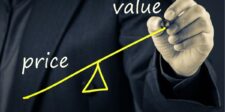When budgets are tight, timelines are short, or deals look tempting, it’s easy to chase what looks smart on paper and miss what it costs to maintain, implement, or recover from. That’s where smart businesses quietly lose momentum—by optimizing for price instead of impact.
The difference between price and cost isn’t a finance lesson—it’s a leadership filter. In this guide, we’ll show you how to evaluate purchases, tools, and vendor decisions through a strategic lens, so you can stop buying reactively and start protecting your margin, time, and long-term value.
How Cost and Price Actually Differ
People mix up cost and price all the time, and it’s easy to see why they’re often used side by side. But once you break them apart, the difference is huge. Price is the number you see right away; cost is everything else that comes with that decision. Understanding the distinction isn’t just helpful, it’s how you avoid spending twice on the same problem.
Here’s a simple breakdown of how they differ:
| Price | Cost |
| The upfront amount paid | The total impact of the purchase over time |
| Clear, visible, often listed | Hidden, long-term, sometimes unexpected |
| Used for comparisons and quick choices | Used for strategic decisions and long-term planning |
| Doesn’t reflect actual value | Reflects effort, maintenance, and opportunity lost |
| Determined by market or seller | Determined by usage, quality, and downstream effects |
| Easy to track on a receipt | Harder to measure, but more important in the long run |
What Is Cost?
In business, real cost shows up in team hours lost, missed sales opportunities, or damage to customer experience. If a tool, vendor, or hire can’t scale with you, the true cost snowballs fast.
Cost is everything you give up beyond the sticker price. It includes your time, effort, repairs, replacements, missed opportunities, and even peace of mind. It creeps in quietly, through delays, poor quality, or unexpected add-ons, and often shows up long after the initial payment is made.
Real cost is rarely upfront. It’s the bill that comes later, when something breaks down, underdelivers, or wastes more of your attention than it ever deserved. Cost is what you’re really paying, even when the price seems low.
Fixed Costs
Fixed costs stay the same no matter what’s going on. You could be on vacation, taking a loss, or having a record-breaking week, these costs don’t care. Rent, insurance, long-term tools, and salaries fall under this category. They offer predictability, which is great for planning, but they can become a trap if you commit to too many of them.
Overloading on fixed costs means your financial stress doesn’t flex with your income. For freelancers, small teams, or anyone trying to stay agile, managing fixed costs carefully can mean the difference between stability and constant pressure.
Example: SaaS subscriptions, salaried roles, office leases, long-term software contracts.
Variable Costs
Variable costs shift with your activity level, which makes them more dynamic but also harder to control. When you produce more, you spend more on materials, packaging, shipping, or extra hands. If things slow down, these costs usually drop, offering some breathing room. The catch is that they’re easy to overlook when things pick up fast.
Without a good handle on them, it’s easy to scale yourself straight into financial headaches. Understanding how your variable costs behave helps you set prices that protect your profit margin and keep surprises to a minimum.
Example: Ad spend, contractor hours, fulfillment costs, per-user billing.
Direct Costs
Direct costs tie directly to the thing you’re selling or delivering. If you’re baking bread, it’s your flour, eggs, and baker’s time. If you’re building a website, it’s the design assets and developer hours. These are the most trackable costs in your operation and usually scale along with your workload.
That’s why they’re essential in pricing: if your direct costs creep higher without notice, your profits quietly disappear. Keeping these tight gives you control, keeps your margins clean, and makes sure you’re not working harder for less money.
Indirect Costs
Indirect costs don’t link to a single sale or project, but they keep the whole operation running in the background. Internet, admin staff, software subscriptions, or rent for the space where work happens, they’re always there, quietly adding up. The tricky part is they’re not always obvious, which makes them easy to miss when budgeting or setting prices.
Businesses that don’t account for indirect costs often think they’re doing better than they are. The solution? Break them down, spread them across your work, and make sure each job is covering its fair share.
🔧 Scattered workflows = silent costs. Sintra helps teams coordinate faster, document smarter, and reduce the friction that bloats timelines and budgets. Clarity saves money.
Marginal Costing
Marginal costing focuses on the cost of producing just one more unit. One more product, one more service, one more client, it sounds small, but it can have big consequences. When you’re operating close to your limits, taking on that “extra” can push you into the red.
It’s not about whether you can do more, but if it’s actually profitable to do so. Marginal costing helps you step back, run the numbers, and make calls based on long-term sustainability, not just surface-level gains.
🤔 Struggling to weigh short-term price vs. long-term cost in your business decisions? HelperX Bot can help you break down total cost, compare pricing models, and make smarter, faster calls—without second-guessing your strategy.
What Is Price?
Price is a positioning tool. Whether you’re the buyer or the seller, understanding how pricing is structured helps you make decisions that align with growth, not just savings.
Price is what you pay upfront. It’s the number on the tag, the figure on the invoice, the amount deducted from your account. It’s immediate, visible, and often the only thing people consider when making decisions. That’s where the problem starts, because price is only part of the equation.
While cost reveals the full impact of your choices, price reflects the strategy behind the number. Businesses don’t just make up prices. They follow models, each with different goals, risks, and signals to the customer.
Here are the common pricing strategies that shape what you actually pay.
Value-Based Pricing
Value-based pricing is all about what the product or service is worth to the customer. Instead of focusing on what it costs to make, this model sets prices based on the result, experience, or transformation it delivers. It works especially well when the stakes are high or the solution is meaningful, think expert consulting, design, or tools that save hours of work.
Customers aren’t paying for features; they’re paying to fix a problem or unlock a better outcome. If the perceived value is strong, the price holds up. It’s a strategy built on connection, not cost.
A good example is when you’re selling services or high-impact solutions, value-based pricing increases both margin and perceived authority
📈 Don’t just look at subscription price—look at what it replaces. HubSpot CRM centralizes your customer data, automates workflows, and cuts the cost of missed follow-ups or untracked leads. It’s not just software—it’s leverage.
Competition-Based Pricing
Used by marketers in saturated industries to stay relevant—but risky without brand differentiation. This strategy centers on what everyone else is charging. You look around, study the going rates, and choose to go slightly under, slightly over, or land somewhere in the middle. It’s a quick way to stay in the game, especially in crowded markets.
The risk is falling into a price war or devaluing your offer just to stay relevant. If you’re not careful, you end up mimicking the market instead of leading it. Long-term, competition-based pricing needs a strong brand and clear positioning to avoid blending into the noise.
Cost-Plus Pricing
Cost-plus pricing is simple: calculate what it takes to produce or deliver the thing, then tack on a margin. It’s a favorite for businesses that want predictability and don’t want to play guessing games with their pricing. While it’s easy to use, it doesn’t account for market demand, perceived value, or competitor pricing.
You could undercharge and lose money, or overcharge and stall sales, without realizing why. It works best when paired with awareness of customer expectations, not just spreadsheets.
Dynamic Pricing
Dynamic pricing is flexible and responsive, adjusting in real-time based on supply, demand, timing, or user behavior. It’s how airlines, rideshare apps, and booking platforms operate, prices rise or fall depending on what’s happening at the moment.
For businesses, it’s a powerful way to optimize revenue. Smart for SaaS, eCommerce, or high-volume services. For customers, it can feel like a moving target. This model requires clear communication and fairness. If the logic behind the changes isn’t transparent, it starts to feel like manipulation instead of strategy.
What Actually Affects Cost?
Cost doesn’t just come from a purchase, it’s shaped by everything that happens around it. You can buy the same thing in two different situations and end up paying very different long-term prices. Here are some of the key drivers that quietly (and sometimes quickly) raise your real costs.
Risk: Every choice carries risk, and risk is expensive. When you go with a cheaper supplier, hire someone with less experience, or use untested software, you’re gambling. If things go wrong, you pay for it in delays, do-overs, lost customers, or flat-out failure.
Inflation: Inflation quietly eats into your budget whether you notice or not. As prices rise across the board, the cost of materials, labor, shipping, and just about everything else creeps up too. What seemed like a great deal last year might feel overpriced today, even if the listed price hasn’t changed.
Time: Time is a sneaky cost driver. The longer something takes to deliver, set up, or maintain, the more it eats into your schedule, and time isn’t free. Projects that drag out, tools that require steep learning curves, or services that slow down your workflow all quietly raise the total cost.
Quality: Low quality leads to higher cost, it’s that simple. If the thing you bought doesn’t last, perform, or satisfy, you’ll be spending again sooner than expected. That might mean replacements, fixes, upgrades, or full-on rework.
Opportunity Cost: What you give up by choosing one thing over another. When you spend money, time, or energy in one place, you’re locking yourself out of other possibilities. It’s not always visible, but it’s real, and it can sting.
What Actually Affects Price?
Price doesn’t just reflect how much something costs to make, it’s a calculated move. Businesses set prices based on strategy, positioning, perception, and timing. The same item can cost twice as much depending on where, when, or how it’s sold.
Market Demand – When more people want something, the price goes up. That’s basic supply and demand, and businesses use it to their advantage. If a product or service becomes popular, scarce, or seasonal, prices are raised to match the urgency.
Perceived Value – What something is worth to a customer often matters more than what it costs to produce. That’s why branding, packaging, presentation, and storytelling can elevate the price without touching the actual product.
🎙️ Want to charge more and deliver on experience? ElevenLabs gives your content a professional voice with AI-generated audio that’s lifelike, brand-consistent, and built to impress.
Cost Structure – Behind every price is a structure that includes raw materials, labor, logistics, and operational expenses. A business with higher internal costs, like custom production, specialized labor, or tight margins, has to charge more just to break even. Cost-plus pricing often starts here, where the business markup is based on what it takes to stay afloat.
Competition – Prices don’t exist in a vacuum. Competitors influence what customers are willing to pay, and businesses adjust based on what others in the market are doing. If similar products or services are priced lower, you either need to justify the difference or adjust to stay in the game.
Target Audience – Who the product is for matters just as much as what it is. Prices are shaped to match the expectations, spending habits, and emotional triggers of a specific audience. What works for bargain hunters won’t work for luxury shoppers.
Economic Conditions – The broader economy has a direct impact on pricing. In tight markets, companies might lower prices to stay competitive or appeal to cautious buyers. During strong economies or post-crisis rebounds, prices rise as consumers become more willing to spend.
Real-World Examples of Cost vs. Price
Seeing the difference between cost and price is easier when you look at what actually happens after the purchase. These examples show how a low price can lead to high costs, and how a higher price sometimes saves more than it spends.
Example 1: Cheap Freelance Work
You hire a freelancer to build your website for $300. The price looks great, especially compared to agencies charging thousands. Two weeks in, deadlines are missed, communication is spotty, and the final product is buggy.
You spend hours fixing things, chasing revisions, and eventually pay someone else to clean it up. That $300 price turned into triple the cost when you factor in your time, delays, and second contractor. The original price didn’t cover what you actually needed.
Example 2: Budget Appliances
You buy a $200 washing machine that looks decent online. It works for a while, but within a year, repairs start piling up. Replacement parts are hard to find, customer service is nonexistent, and you’ve taken multiple days off waiting for technicians.
After 18 months, it dies, and you replace it with a $600 model that could’ve lasted ten years from the start. The low price was easy to justify, but the cost made it the most expensive option in the end.
Conclusion: Price Is Visible—Cost Is Strategic
Most bad business decisions don’t look bad at the start—they look cheap. That’s the trap. Entrepreneurs and teams get lured in by low prices, only to realize too late that what they bought didn’t scale, didn’t deliver, or silently drained resources behind the scenes.
Price is the number you see. Cost is what it takes to live with that decision over time.
If you’re building something that lasts, your real advantage isn’t in finding the lowest number—it’s in recognizing the true impact. What’s the onboarding time? How much support does it need? Will this tool save hours or create new bottlenecks? Does it improve the customer experience or bury your team in workarounds?
Whether you’re buying software, hiring help, or setting your own pricing, the smartest business move isn’t always the one that looks easiest on paper. It’s the one that pays off in outcomes, not just optics.
Treat every purchase as a strategic investment. Use cost as your lens—not just price—and you’ll stop spending reactively and start scaling intentionally.
💡 The smartest business owners don’t just look at price tags—they calculate impact. Use HelperX Bot to clarify ROI, assess vendor fit, and turn financial instinct into data-backed confidence.
Frequently Asked Question
How do businesses calculate true cost before making a decision?
Most businesses use a mix of forecasting, cost analysis, and scenario planning to estimate the total cost of ownership. This includes not just the purchase price, but also long-term expenses like maintenance, support, and opportunity costs that may affect performance or growth.
Can a higher price always guarantee lower cost in the long run?
Not always. A higher price can reflect better quality or service, but it still depends on how well the product or solution holds up over time. Smart buyers look for alignment between value, durability, and ongoing support, not just price tags.
Why do some companies still prioritize low prices over long-term cost?
Short-term goals, tight budgets, or pressure to reduce spending often push decision-makers toward the cheapest option. It feels like a win upfront, even if the long-term outcome leads to higher hidden costs or performance issues that undo the savings.
Related:
- Money Stress and Mindset: How to Regain Focus and Confidence in Your Business Journey
- How to Build a Mindset for Business
- How to Become a Money Magnet: Boost Your Wealth Potential

We empower people to succeed through information and essential services. Do you need help with something? Contact Us.
Want a heads-up once a week whenever a new article drops?







